Staff Professional Development
Learning is a continuous act. It is something that we must consciously cultivate in order to make informed decisions in the classroom.
Headteacher David Sammels
This document is designed to clarify Mayflower’s way of working; its philosophy (influences and thinking), its methods (working), its culture (being) and its intended impact (products). It pulls together three areas of development, Mindset, Skillset and Toolset and explains the part played by Continuous Professional Development.
Clarifying Thinking Through Continuous Professional Development
Mayflower’s approach to continuous professional development, aims to create the conditions for staff to respond dynamically when, managing the pressures of system change, develop a deeper sense of professional identity, whilst making informed choices. We aim to encourage staff to
a) improve life choices for pupils
b) remain able to respond to system change
c) influence the educational landscape through a continuous process of research and development
d) navigate a personal career path or remain agile and positive as they age.
Why | What | How (template)
Creating the conditions for learning to take place is fundamental to staff feeling ready and able to learn. With such busy timetables, teachers must be supported to understand how their mindset links to how ready they are to develop their skillset and how confident they are about creating or using a new toolset.
image
Why | What | How (worked example)
The link between the 'Why | What | How' of teaching (also referred to as Mindset | Skillset | Toolset) is mapped as a worked example below.
image
What’s important to us?
Mayflower is a place that dynamically develops people. We support staff to progress in their careers by enabling them to strategically influence the system in which they serve. We do this by challenging staff to innovate and make meaningful change (in order to improve the life choices of pupils and their wider community). We develop people’s professional capabilities.
Staff are supported to offer the wider educational system an informed opinion on what works in the classroom, whilst inviting respected feedback (sharing) from cross industry experts. This way of working has become a crucial part of Mayflower’s professional culture.
As part of this culture, we expect staff to sign up to the process of continuously reflecting and refining their practice. Staff need to enter into an informed process of continuous professional development (CPD), which we deem as being a process of continuous Research and Development (R&D).
By continually developing the talents and interests of people, both personally and professionally, staff are able to design ways of sustaining school improvement. They engage in activities that are aimed at identifying the most impactful methods of teaching, learning and assessment. They then use this knowledge to maximise the time our wider community spends being exposed to these methods (both at school and within their wider community). Staff consider every option for increasing their communities’ exposure to learning and explore methods for raising the profile of learning. By doing this, Mayflower works in tandem with its partners to generate a sense of collective responsibility for the educational outcomes of pupils.
Why is it important to build a model of continuous professional development?
Teaching, as a complex and progressive profession, places certain pressures on a teacher. We recognise that teachers start their careers eager and keen to learn. They sign up to making a difference to the pupils they serve. Very soon into their careers, teachers develop a sense of how external policies and procedures impact on their ability to manage these admirable aspirations. Therefore, as a way of helping their enthusiasm and ideas push beyond their external pressures, teachers benefit from having a blend of guidance and structured study (CPD).
The image below identifies the external pressures that influence teachers. It demonstrates the staff member being pulled in different directions which in turn creates a sense of professional tension. Mayflower refers to this process as the Diamond of Pressure. It is often the staff members own ideas (the, ‘I think…’) that gets lost in the mix, causing anxiety and a sense of system based dependency.
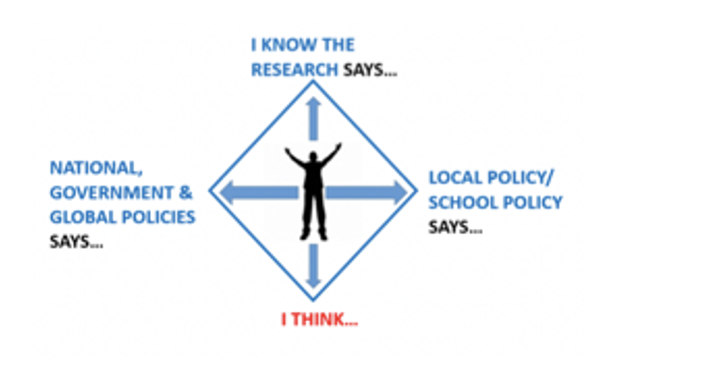
To avoid professional tension, staff are supported to engage in a carefully designed model of CPD. They study the most effective methods of practice and challenge not just their own beliefs, but those too of Mayflower itself. System based policies and procedures, as well as classroom practice, are directly informed by this process. Instead of building tension, staff become hungry for change and are empowered to shape their own school based system. They become excited to work and serve at a setting that continuously strives to become a centre of research and development. The aim is that staff become less dependent on the system and being fed ideas and more independent – growing their own - informing and shaping the system in which they work.
How will our model of CPD be implemented?
As staff become more confident with implementing their ideas, they develop a sense of personal and professional identity. They create experienced based opinions. They begin to develop professional capabilities. Our capabilities model is organised into 3 interrelated layers:
- MINDSET:
Clarify our why?
Declare why do we do what we do?
- SKILLSET:
Clarify our what?
What methods of research and development will we use to sustain improvement and develop people?
Define our approach towards achieving and sustaining our why?
- TOOLSET:
Clarify our how?
What methods do we use to teach, learn and assess?
When these 3 layers of capability - Mindset, Skillset and Toolset are effectively combined, they enable staff to become professionally mature because by enabling them to back personal opinions up with evidence.
The next three images demonstrates how Mayflower’s model of CPD integrates three additional layers of capability to a staff member’s existing professional approach.
Creating Capabilities
Image of 3 layers
Defining Capabilities
“The power or ability of someone to do something”
Through collaborating with each other on study modules (skillset), staff develop their professional capabilities. Staff work at attracting energy, interest, income and expertise from outside the school in order to attract additional critique and feedback. By engaging with wider community members in learning, staff’s ideas and theories go beyond the school gates. Staff develop their ability to publish their ideas and findings about what works in their classroom way beyond their postcode.
“Ideas won’t keep. Something must be done about them”.
Alfred North Whitehead
Staff are expected to think hard for themselves, to search and seek for evidence of impact, and to question and explore their opinions and those of colleagues globally. We want our staff to feel like they have something to say - something of worth that helps the education system remain meaningful and relevant. Mayflower’s WHY (their mindset) and WHAT (their skillet) are both relatively fixed in approach. This is because they are rooted in school based values.
‘Together we can…create leadership and learning good enough to share’.
Skillset development follows a general set of rules. A step by step process.
1. Skillsets and theory are introduced and staff immerse themselves in the theory.
2. Imbedded in practice
3. Stress tested in theory, classroom practice and evaluated outcomes
4. Innovated into the wider practice of colleagues (where relevant).
Skillset
“The ability to perform a skill – a person’s range of skills or abilities”
Mayflower's systematic approach to school improvement via continuous professional development, leads to trust being built between colleagues and a sense of safety within Mayflower’s, ‘Together we can…’ ethos. Ultimately, the process of introducing, imbedding, testing and innovating) enhances staff’s ability to dynamically develop new innovative methods through the creation of evidence informed and ever evolving toolsets. This process has become Mayflower’s approach to innovation. It is underpinned by a staff member’s ability to develop their capabilities through the process of deliberate study and skillset development.
Skillset | Challenging beliefs to inform and fuel educated action
The following diagrams model a staff member’s skillset bridging the gap between their mindset (beliefs) and their toolset (ways of doing things). All parts of this model act to inform each other. They make up the parts of a whole way of thinking and working. The model creates the platform for research informed toolsets to be created and applied effectively in the classroom. This cycle of research and development acts as a self-fuelling process of reflection and refinement. It directly impacts on both policy and practice. It empowers staff to support and challenge education-based decisions.
Image
Research and Development: Creating Capabilities.
Step 1: Have a mindset (beliefs)
Step 2: Develop a skillset (capabilities)
Step 3: Link Mindset with Skillset and apply via an informed Toolset.
An informed toolset is therefore deliberately and collectively created and applied by staff through the systematic process of studying. Staff study by introducing ideas (mindset), questioning and exploring, testing (skillset) and then innovating (toolset).
Image
Mindset | WHY? Staff are encouraged to listen first before doing as they are inducted and immersed into Mayflower’s, ‘Together we can…’ based beliefs. Staff are attracted, hired and arrive already having a compatible ‘Can do’ mindset.
Image
Skillset | WHAT? Staff are encouraged to question and explore their ideas and wider theory. They are supported to find the point of conflict in practice, think deeply about this, and articulate differing educational perspectives.Mayflower provide the systems to develop a staff member’s research informed skillset.
Image
Toolset | HOW? Staff are encouraged to lead with confidence, applying informed methods of teaching. A research informed toolset, strengthens Mayflower’s collective mindset and its, ‘Together we can…’ ethos. An informed toolset is collectively created and scaled for use in the classroom.
In Conclusion
Mayflower’s vision is to become a centre of continuous research and development. In order to achieve this, staff are guided through a progressive model of CPD.
Staff move swiftly from an immature state of dependency towards a more professionally mature state of interdependency (Covey 2013). Staff systematically develop a personal and professional identity informed by both their experience, but also an awareness of what works in the classroom. Mayflower’s staff develop the capacity to make informed decisions in the classroom and collectively support each other to innovate practice and
- improve life choices for pupils
- remain able to respond to system change
- influence the educational landscape through a continuous process of research and development
- navigate a personal career path and remain positive and agile.
Mindset at Mayflower
Declarations
We believe that teachers who create a legacy of pupil achievement are able to make informed and effective decisions. They can articulate their choice of pedagogy (their what, how and why), and demonstrate their approach as a generative activity.
We believe that teachers develop a sense of professional confidence by working in teams to actively participate in a cycle of continuous reflection and refinement. They check in with each other to check out what works best in the classroom.
We believe that effective teachers actively seek opportunities to research, test and share both their own findings and those of others. They compare and contrast differing approaches to pedagogies searching for the most impactful methodologies.
We believe that the most effective teachers test opinions and theories in the classroom, taking collective responsibility for outcomes by openly sharing practice and inviting wider cross industry critique.
We believe that the most effective teachers sustain curiosity and develop an infectious desire to continuously improve.
We believe that the most effective teachers develop a culture of informed change by searching both within their institution and across industry, noticing the most impactful leadership behaviours.
“Concerning the science of learning, generative learning takes place when the learner engages in appropriate cognitive processing during learning, including attending to the relevant information (i.e., selecting), mentally organising incoming information into a coherent cognitive structures (i.e., organising), and integrating the cognitive structures with each other and with relevant prior knowledge activated from long term memory (i.e., integrating)”
Fiorella and Mayer (2015).
“…new vistas are opened up when we read about considered practice.”
Myatt, (2016)
“Everything works somewhere and nothing works everywhere”
Wiliam, (2016)
“People are naturally curious, but we are not naturally good thinkers; unless the cognitive conditions are right, we will avoid thinking.”
Willingham, (2009)
Attributes and Characteristics of an Effective Teacher
We believe that in order to build upon and develop the Mayflower Continuous Professional Development Package, it is necessary to define the attributes and characteristics of an “Effective Teacher”.
Defining these attributes and characteristics may delve into personal realms and opinions, therefore the following attributes and characteristics have been collated from evidence based research.
We encourage every member of teaching staff to be honest, open and self-reflective when reading the attributes and characteristics- asking themselves which of these attributes and characteristics do I really display? Which of these attributes and characteristics could I develop further?
|
Whilst comparing the images and the descriptions of an Effective Teacher and an In-Effective teacher, it is worthwhile to note that Walls et al (2002) state that the research comparing the effectiveness of teachers are “by no means mirror-images of each other… more verb referent statements about emotional climate, care about students, interaction with students, learning activities, discussion and teacher or student questions were reported for effective teachers than in-effective teachers.” |
What makes an Effective Teacher?
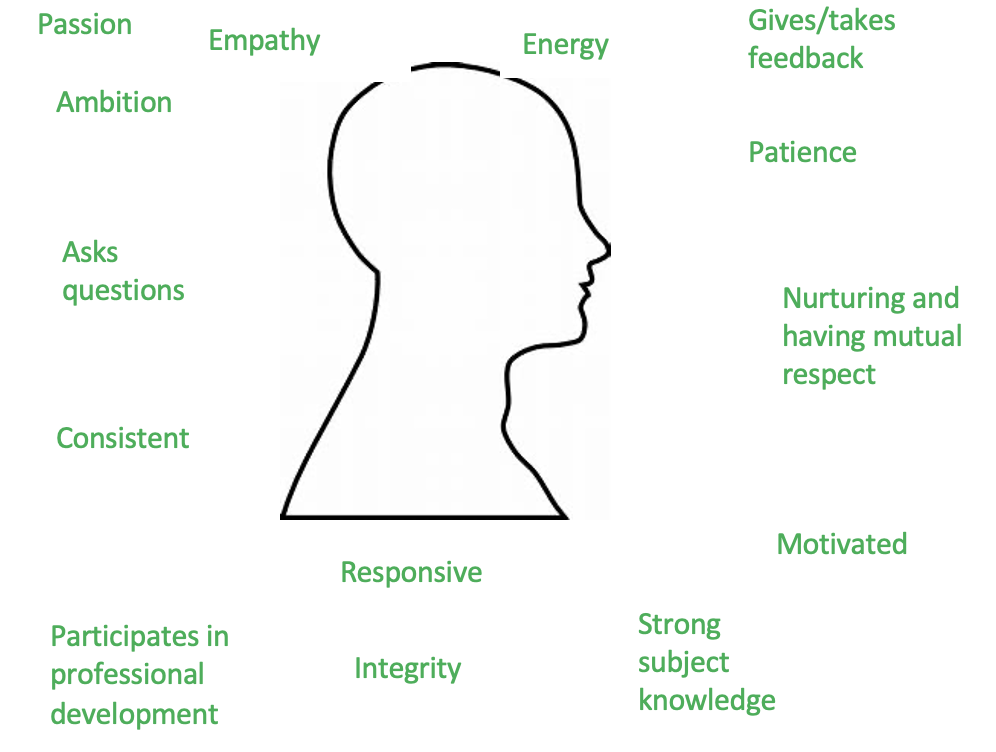
MacMillan (2018, Sherrington (2017), The Sutton Trust (2014)
Attributes and Characteristics of an In-Effective Teacher
Whilst being open and self-reflective, it is important to view and understand what evidence based research claims to be the attributes and characteristics of an “In-Effective Teacher”
What makes an In-Effective Teacher?
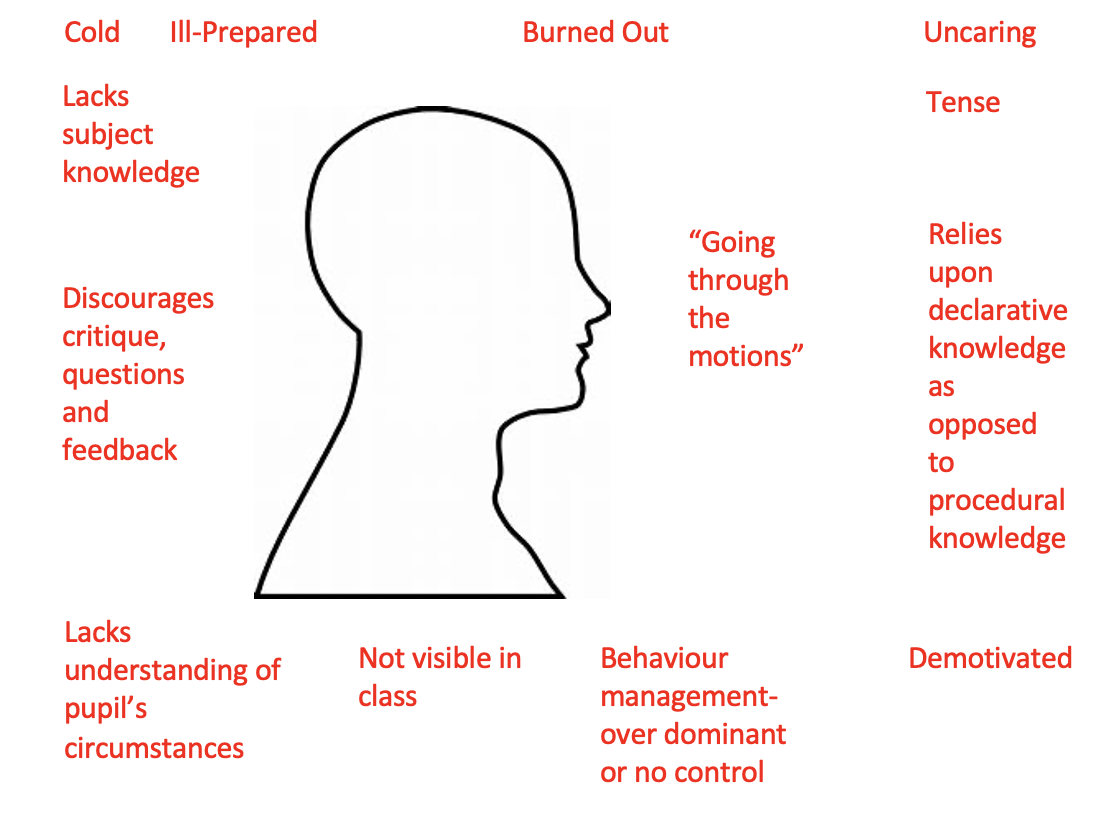
Lavy, (2015) Walls et al (2002),
Influences and Research | An External Literary Review
A Teaching Mind-Set “The Onion Model”
Korthagen (2004) describes teachers as having a certain, commonly shared, flexible yet layered habitual teaching mind-set. The habitual thought patterns showing what, how and why the teacher chooses to teach. This theory is often referred to as an onion because of the layering being compared to the layers of an onions skin.
Image
Layer One of the model discusses the environment and factors which may affect the teacher mind-set such as the classroom, the subject being taught, the school culture and the pupils.
Layer Two focuses on behaviour- how the teacher copes with challenges within the classroom.
Layer Three considers competencies- how secure is the teachers’ subject knowledge.
Layer Four prompts discussion about how the teachers’ prior beliefs and assumptions may affect teacher-mind set.
Layer Five focuses on identity. How the teacher feels about themselves personally and professionally may affect teacher mind-set.
Layer Six focuses on what inspires us as teachers and how motivation plays an important part in having a positive mind-set.
The centre of the Onion model shows “Core Qualities”- these are core qualities that are often recognisable in teachers, i.e. character strengths. Korthagen and Vasalos (2005) represent the interactive relationship between the teachers’ behaviour and this environment as a double headed arrow, indicating a two-way direction of influence between the teacher and the classroom environment Each layer underpins the next.
Cain (2019) denotes that, …
”to develop better teaching mind-sets it is helpful to look beyond the school, which is where outside, academic research can contribute.”
How does Research Expand Teaching Mind-Sets?
McIntyre et al (2005) state that research generates only information and information is part of a teaching mind-set only when it becomes a belief. How many times have you heard discussions in staff rooms or meetings where teachers and staff have commented “But we always do it like that…”? Teachers have believed the way that they teach is the correct way because that is how it has been presented for a certain, perhaps prolonged period of time. It has become a belief and the teacher feels comfortable, secure and competent in the knowledge and how to present. Why would this need to change?
As teachers, one of our core qualities is that we genuinely care. We want the very best for the pupils that we teach. When teachers are presented with research we want to know that it is credible and relevant. As Cain (2015a) discovered in a study that if the teacher did not believe the research to be credible and of value, then the finding of the research would be rejected. However, if the teacher accepted the validity of the research it led to a change in teacher behaviour (depending on the other contributing factors discussed in the Korthagen “Onion Model”, 2004).
Influences and Research | An External Literary Review
Bell and Gilbert (1996) conducted a three-year research project focusing on the professional growth of science teachers, when learning and teaching new material.
The Model of Teacher Development shows that the teachers felt there were three inter-connecting areas of development:
- Social Development
- Professional Development
- Personal Development
Social Development
The teachers felt that often the teaching profession can be isolated. They wanted opportunities to work collaboratively- to discuss, refine and reflect together.
Professional Development
The teachers felt that having professional development opportunities supported their new scientific learning. They felt that it was important to have professional development allocated time that allowed them to study as well as try out the new activities.
Working collaboratively during the professional development sessions allowed the teachers to discuss and develop their ideas for classroom practice. The professional development sessions enabled the teaching staff to feel excited, enthusiastic and empowered in their new learning and encouraged them to initiate other development activities.
Personal Development
Throughout the research study, the teachers were self-reflective and began to identify aspects within their teaching practice that may be problematic, or could be enhanced and developed further. The teaching staff expressed their vulnerable, human, emotional sides of being teachers and recognised that external influences can sometimes become restraining and block out receptiveness to learning and teacher development. The teachers identified that they felt empowered to continue learning (academically, socially and emotionally).
Summary
The model of Teacher Development (1996) clearly shows that to develop the traits, attributes and characteristics of an effective teacher, there must be consideration for the three areas of development: Social, Professional and Personal. The three areas of development are inter-connected, each heavily influencing the next. One cannot be seen as valid, without the other. Combining the “Onion Model” (Korthagen, 2004) with the research from what makes an “Effective Teacher” (Lavy, 2015, MacMillan, 2018, Sherrington, 2017, The Sutton Trust (2014) Walls et al, 2002 and The Model of Teacher Development (Bell and Gilbert, 1996) a clear picture of how to support teachers with their Continuous Professional Development is beginning to emerge.
"Every teacher needs to improve, not because they are not good enough, but because they can be even better...The best way to improve as a teacher is to watch yourself in action - it is like holding up a mirror your practice"
Dlyan William
Influences and Research | An Internal Evaluation Process
The Importance of Looking Within
Guskey, (2000) states that in auditing or “evaluating” a professional development package, there are three purposes of evaluation. These are: Planning Evaluation, Formative Evaluation and Summative Evaluation.
The three purposes of Evaluation are then defined further and split into 5 “Critical Stages of Evaluation” (See Appendix One for complete table of Evaluation Processes)
- Level 1 Participants’ Reaction
- Level 2 Participants’ Learning
- Level 3 Organisation Support and Change
- Level 4 Participants’ Use of New Knowledge and Skills
- Level 5 Student Learning Outcomes
Guskey, (2000)
Building upon the prior knowledge learned from the evidence-based research regarding the Attributes and Characteristics of an Effective Teacher, Teacher Habits and the Teacher Development Model- the next step was to complete as Guskey (2000) states a “Planning Evaluation- Level 1.”
Guskey (2000) discusses that most “Level 1 Participants’ Reaction Evaluations” are questionnaire based. Surveys and questionnaires can have limitations as a reliable source of data. Therefore, each question had the opportunity for staff to comment further, the surveys were anonymous and finally the surveys were online, so teaching staff could access them at a time suitable and chosen for themselves. All teaching staff at Mayflower Community Academy were asked to complete the online survey. The purpose and focus of the survey was to evaluate Mayflower's Community Academy CPD Package, which had been adapted to incorporate Remote Learning CPD due to the unexpected COVID 19 outbreak. Using the outcomes from Evaluation Level 1, it would allow us to progress onto Level 2-Participants’ Learning.
The following questions and data analysis show a snapshot of staff opinion.
1. Style of CPD Meetings: Face to Face Whole Academy Meetings or Different Styles of CPD (inc Remote Learning, Smaller Teams and Whole Academy)
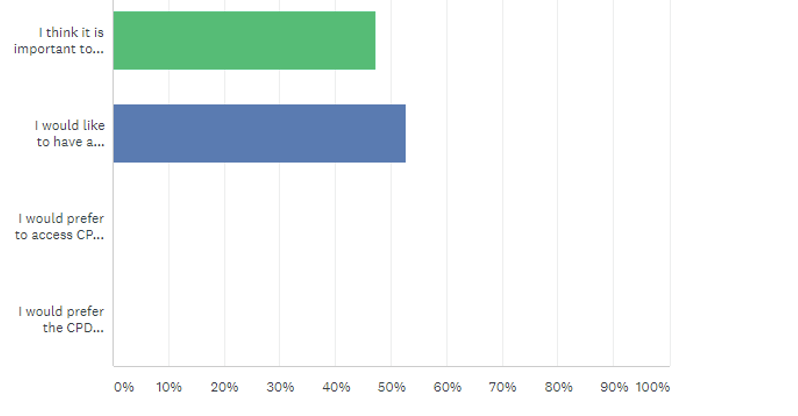
48% Face to Face Whole Academy CPD.
52% Different styles of CPD including Remote CPD, Smaller Teams and Whole Academy Meetings.
2. The Focus of CPD Sessions 2019-2020 were Primarily Based Around Research and Theory. Should This Continue or Become More Classroom Based?
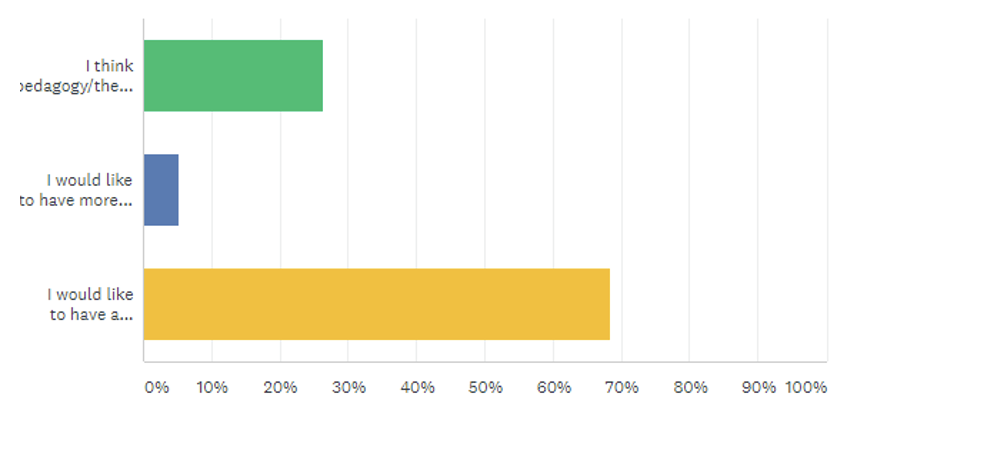
27% CPD sessions should only cover Pedagogy, Research and Theory
5% CPD sessions should focus on classroom based learning and activities
68% CPD sessions should be a balance between Pedagogy, Theory, Research and how to implement this learning into classroom practice
3. How Can We Support You Further in Your CPD? (Answer more than 1 if applicable)

37% Would like a coach/mentor
47% Would like opportunities to attend external CPD
11% Would like to complete further academic courses
63% Would like to work in teams/working parties
37% Would like to create a personal CPD portfolio
42% Would like to access a remote CPD package
58% Would like to shadow other members of staff
4. Which Type of “SHARE” would you be comfortable with?

72% Creating a personal portfolio and sharing within a team
39% Speaking at an “Open House” within the Academy, to the local community.
28% Speaking at a local “Open House” and having speech recorded to be shared via social media.
28% Speaking in a “TEDTALK” style.
28% Speaking at a national conference e.g. Researched
5. Time – How much time are you able to offer to support your CPD package?
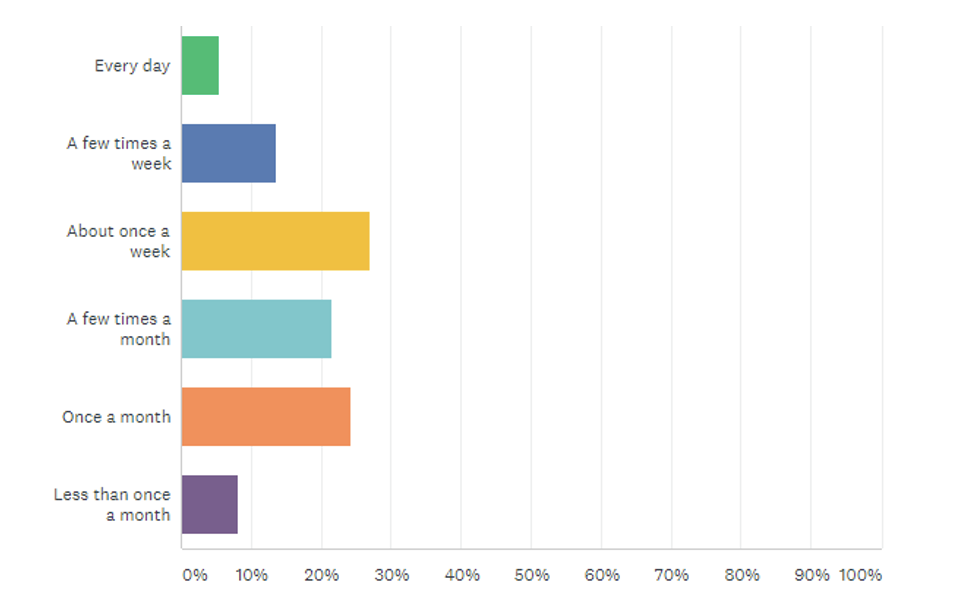
5% Everyday
14% Few times per week
27% Once per week
22% Few times per month
24% Once per month
8% Less than once per month
Influences and Research | An Internal Evaluation Process…
“Openness to possible "unintended learnings," either positive or negative, also should be considered.” (Guskey,2000)
Avoiding the Avoidable
We aim to avoid the situation where teaching staff feel overwhelmed by external professional, personal pressures and demands. Avoidance of staff feeling pushed and pulled in different directions - ultimately diminishing and disempowering personal views, opinions and autonomy, is key to effective professional development. Attention to the needs and wants of staff has ensured that we offer:
Time | Time to pre-read research. Time to attend to new learning. Time to introduce, imbed and test new learning into classroom practice. Time to reflect and refine. Time to share ideas, findings and opinion. Time to self-explain, gain feedback and deepen understanding. Time to look where others aren’t looking.
Space | Space to work with a partner colleague. Space to work in teams. Space to work together as a whole Academy. Space to access CPD remotely.
Resource | Resources given in advance of training. Resources that enhance the teaching and learning. Resources that are shared and easily accessible. Resources that are evidence based, valid and relevant to classroom practice.
Expertise | Expertise from a range of industry experts. Expertise that enables staff to shadow each other. Expertise that allows for a coachee-coach approach, mentor based. Expertise that allows discussions and career “flight path” developments. Expertise that offers challenge through differing perspectives.
Influences and Research | An Internal Evaluation Process
Throughout “Evaluation Level 3 “(Guskey 2000) the evaluation process flows, moving from data driven organisation to information on organisation regarding support and change.
The EEF (Education Endowment Foundation) has produced a Guide to Implementation (2019). The implementation cycle is split into four quadrants: Explore, Prepare, Deliver and Sustain.
“Evaluation Levels 1 and 2” (Guskey, 2000) would be accepted into the first quadrant of the EEF model: Explore. Through the staff CPD surveys and feedback, as an Academy we were able to identify the issues and the priorities for CPD change.
We then systematically analysed the data and feedback and assessed against evidence-based, peer reviewed articles and research. Finally, we were able to take the research and the raw data from the survey to look for trends, patterns and to evaluate if the research helped or hindered the evaluation process.
As we began to examine “Evaluation Level 3” (Guskey, 2000), the EEF Guide to Implementation (2018) acted as a tool to guide the methodology and ensure that the new design of the CPD package was informed by robust, valid, evidence- based research methodologies.
Moving into the second quadrant of the EEF (2018) Implementation Model “Prepare” allowed us to ensure that the CPD package followed a clear plan and was clear to understand. Finally, we were ready to prepare the practicalities- the content design and timetabling.
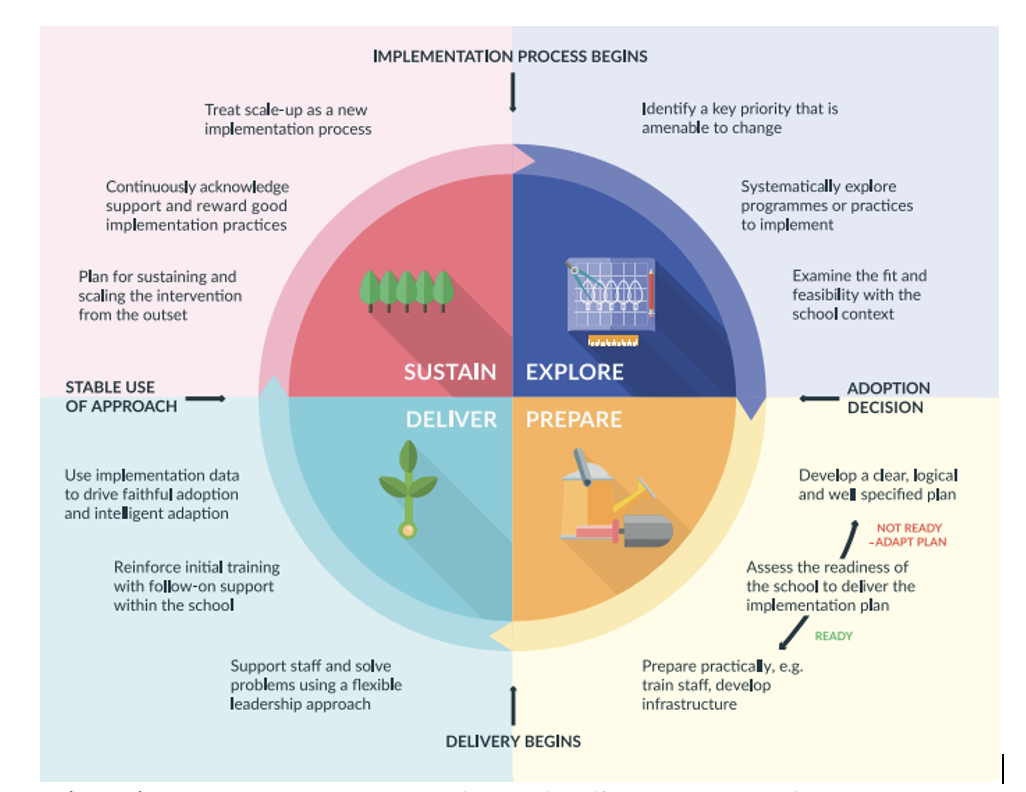
EEF | Putting Evidence to Work: A School’s Guide to Implementation
Influences and Research: An Internal Evaluation Process
Vision | Why?
- A package that is time flexible. We understand the “pushes and pulls” of daily life.
- A package that allows staff to gain prior knowledge about the new learning. We understand cognitive overload and the need for prior knowledge to accept new learning.
- A package that will be led through a model of distributed leadership, including external experts. We understand that some areas of research are more effectively presented by relevant experts.
- A package that enables personal and professional confidences and competencies to develop. We understand the need for staff to feel supported with new learning whilst being able to create both a personal and professional identity.
- A package of learning that staff will feel is relevant, valid and are proud to share. We understand that the new learning needs to be relevant to our teaching. We understand that overcoming challenges = a reason to celebrate.
The CPD Package | HOW?
Intent - Implementation - Impact
- Introduces, imbeds and tests relevant evidence based educational research impacting how pupils learn.
- Recognises new learning (psychological, emotional, physical and relational) as a challenge and provides a supportive, trustworthy, empathetic climate and culture.
- Provides, time, space, resources and expertise to allow personal and professional growth.
- Encourages critical thinking, formative feedback and sensitive debate through a variety of CPD methods.
- Acknowledges that learning is not always linear, therefore having a purposefully designed spiral based professional development package, focusing on modules of new learning intertwined with retrieval and spaced practice opportunities. Learning is introduced, imbedded and tested.
The EEF (2019) state that discussing and imbedding infrastructure is a key element in preparing for delivering effective implementation.
With reference to the Mayflower CPD Surveys, one of the main areas that teaching staff desired, was space to be incorporated into the revised CPD Package.
It is important to clarify the infrastructure of the various elements of the CPD programme.
The practices below, show how at Mayflower we are offering opportunities for teachers to work collaboratively, understanding the importance of “Social Development” (Bell and Gilbert, 1996) having a positive effect on the development of teachers becoming more effective.
“No man is an Island, entire of itself; every man is a piece of the Continent, a part of the main.” John Donne, (1624)
Opportunities and Support for Continuous Professional Development
Intent - Implementation - Impact
Encouraging Collaborative Learning
Termly team planning days
We plan opportunities for staff to reflect and refine and plan ahead within phases and year groups.
Weekly team time for planning, preparation and assessment
Staff have weekly collaborative planning, preparation and assessment sessions within year group teams.
Weekly team phase meetings
Staff are able to take time together in phases to refection and refine systems. These phase meetings are a chance to review evidence of learning, prepare, plan and assess as a small team.
Weekly whole school (where relevant) staff training
Staff get access to weekly face to face / remote online whole Academy CPD sessions. These are opportunities for alignment, new learning, discussing what works, admin, reporting and sharing research and ideas.
Continuous online and remote learning
Staff can access a range of online resources linked to their continued professional development (CPD). All staff have access to LAT wide online portals for linking with wider colleagues with a focus on curriculum. Staff benefit from opportunities for self study and spaced practice of continued professional development through online sessions and pre-recorded CPD videos. Available to access whenever and wherever.
Weekly Mayflower Community Academy Leadership Team (MALT) meetings
Staff have access to content that is discussed during MALT's weekly leadership meetings. The meetings are an opportunity to reflect, refine and strategically plan ahead to achieve school goals and address priorities.
Shadowing, Coaching and Mentoring
Staff have extensive access to counsellors, therapists and LAT based coaches. Mayflower also looks to offer opportunities for staff to shadow and be mentored by internal experts as well as external experts (often these experts span across industry to maximise challenge and curiosity opportunities).
Structure of study for academic year
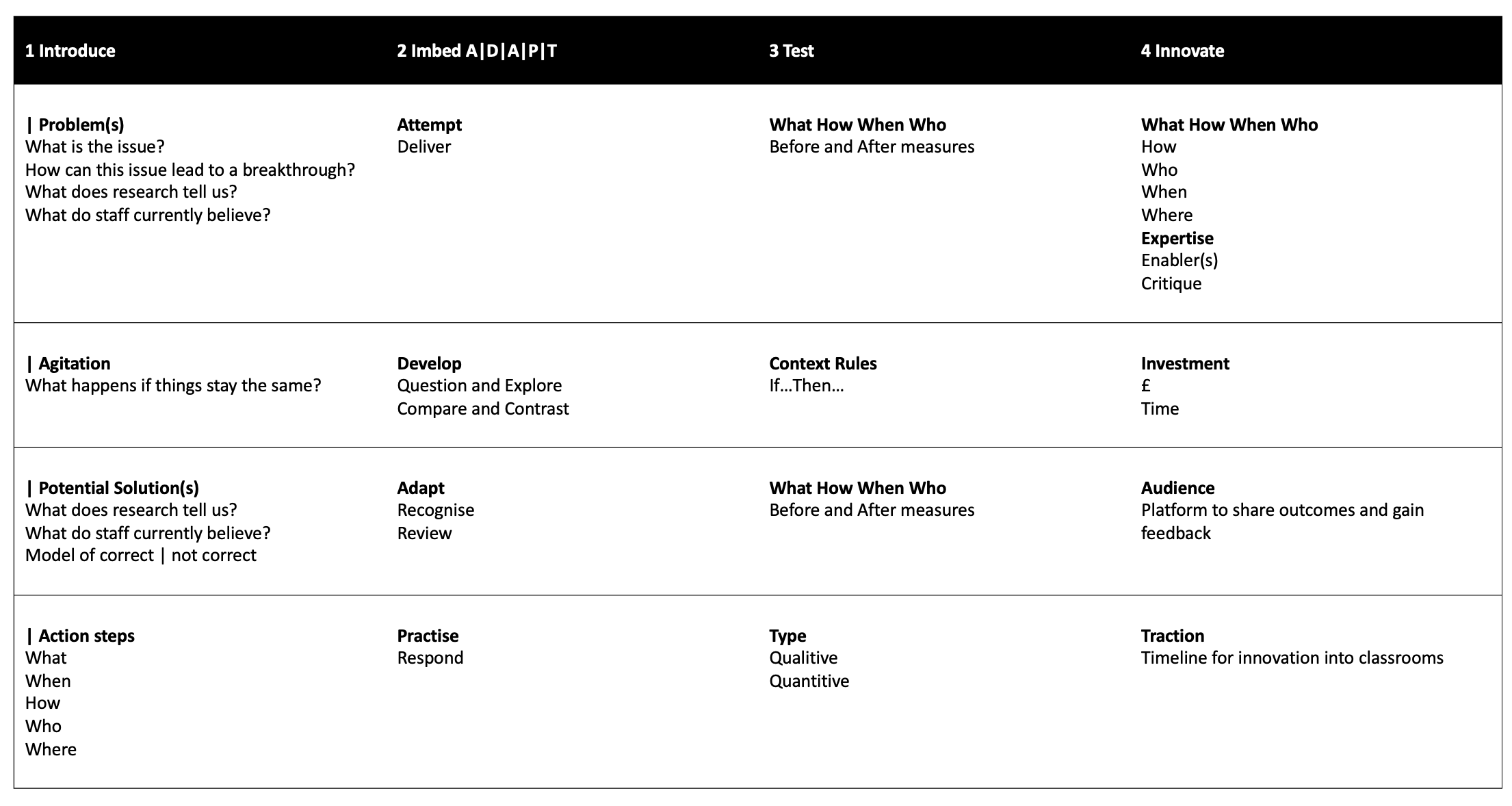
Developing Skillset
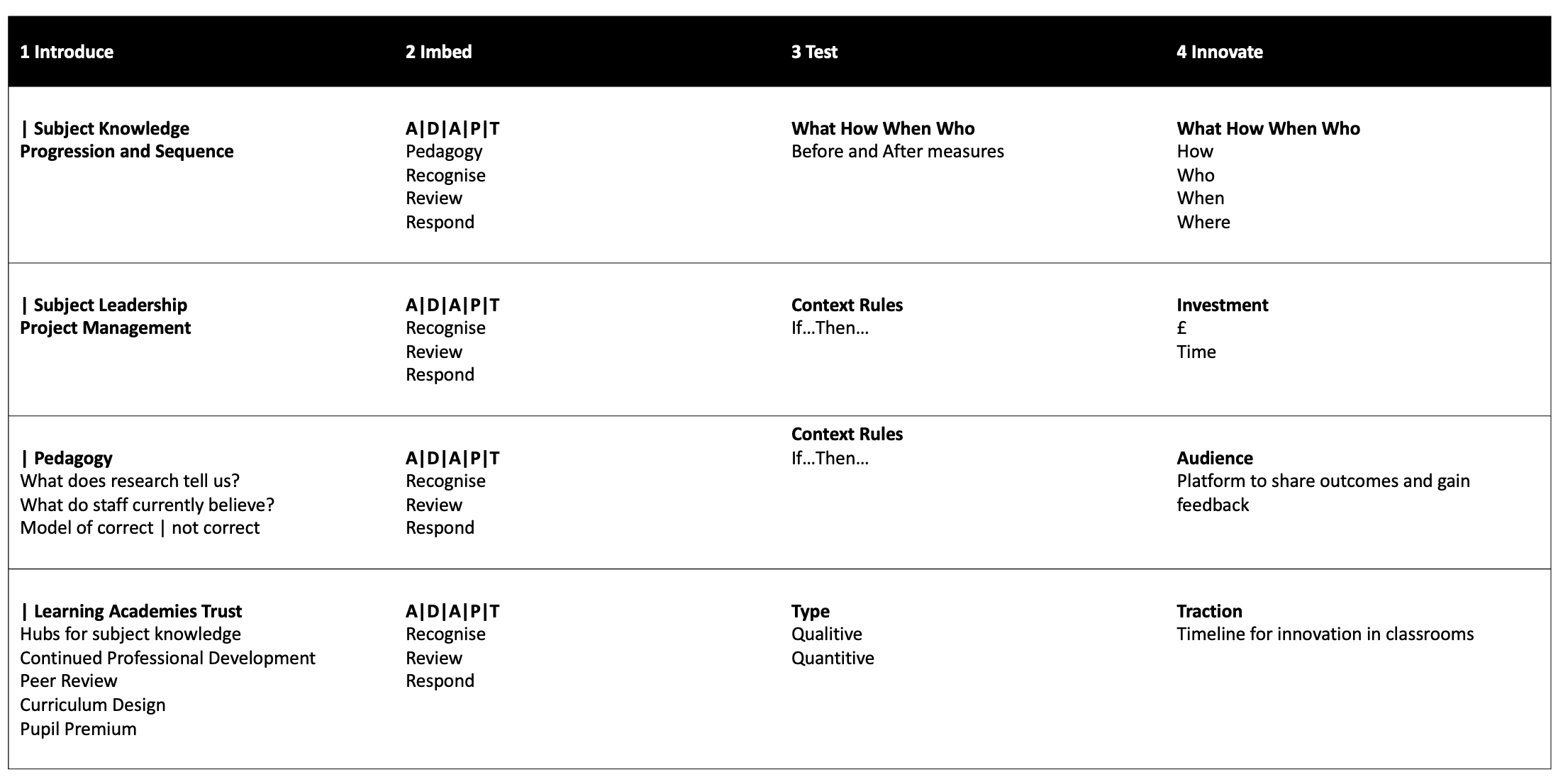

Calendar of study | Autumn 1
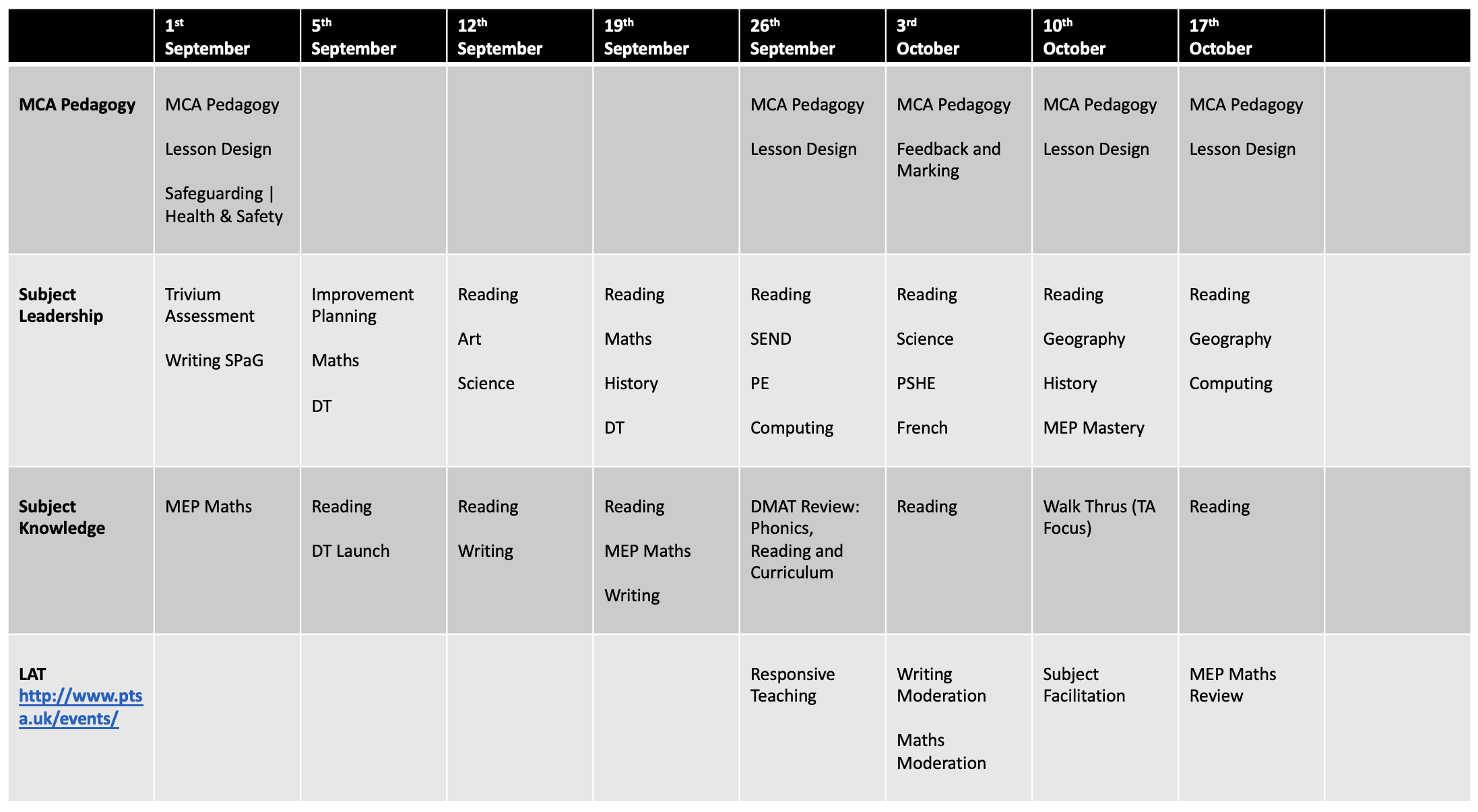
Calendar of study | Autumn 2
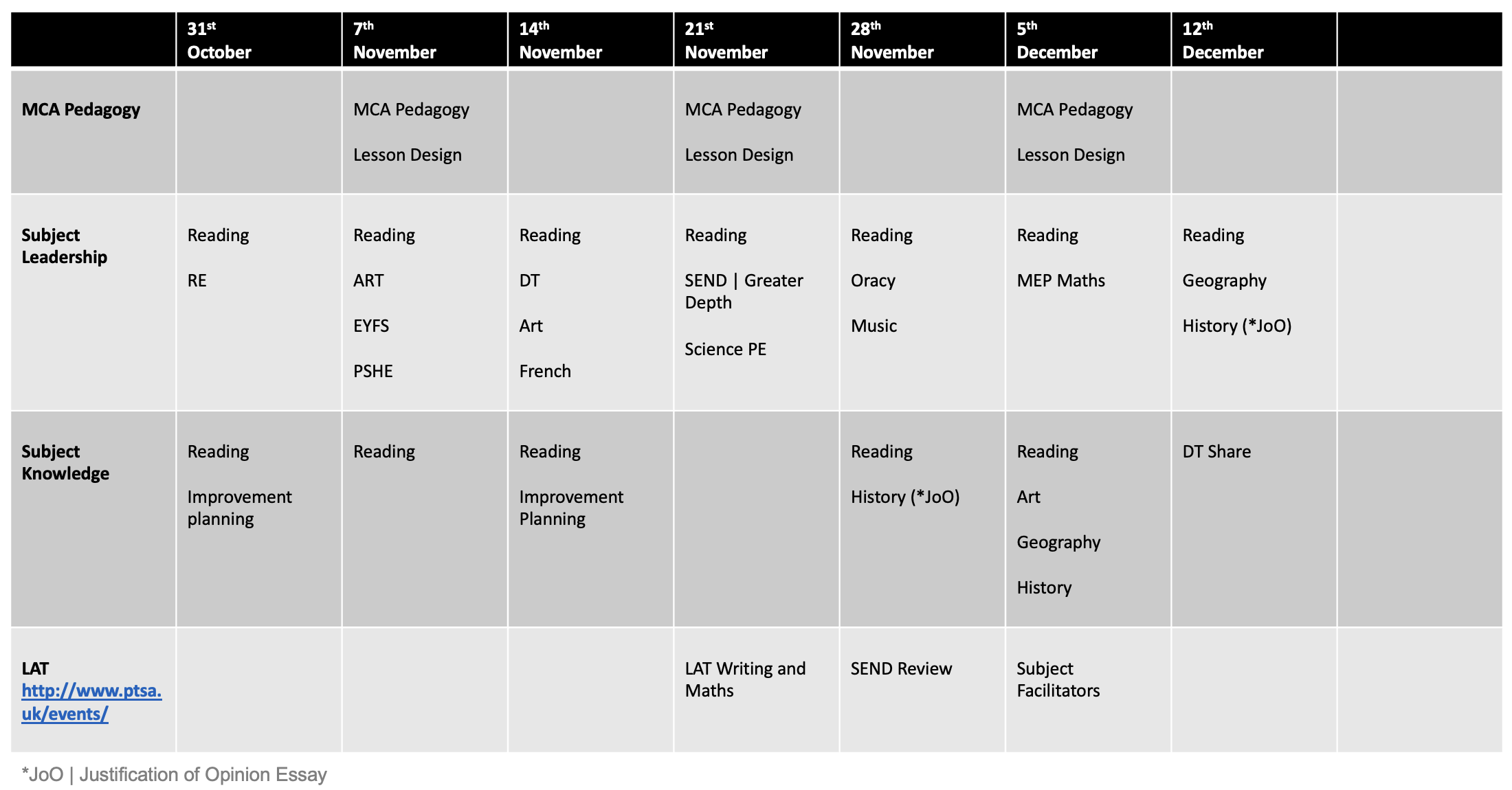
Calendar of study | Spring 3
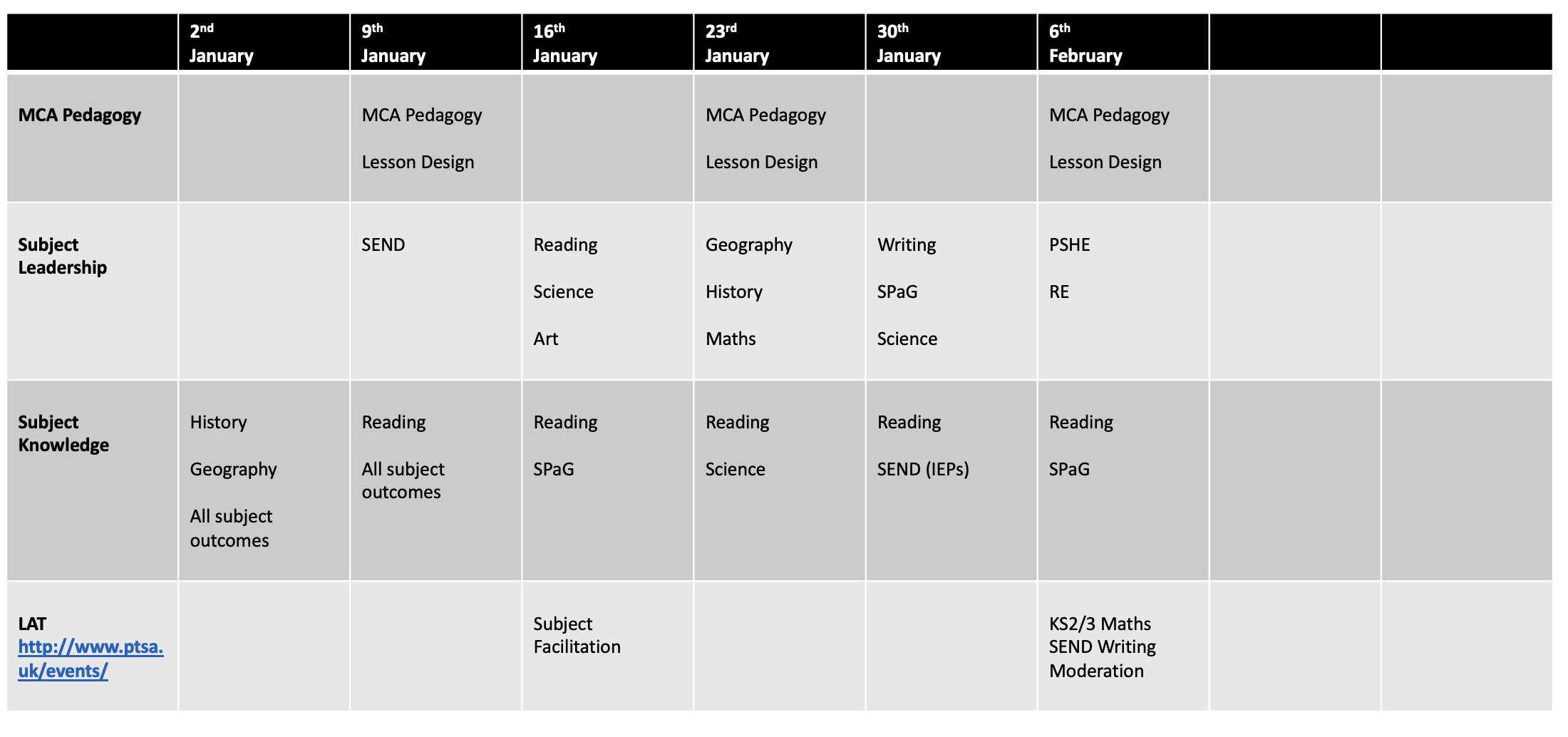
Calendar of study | Spring 4
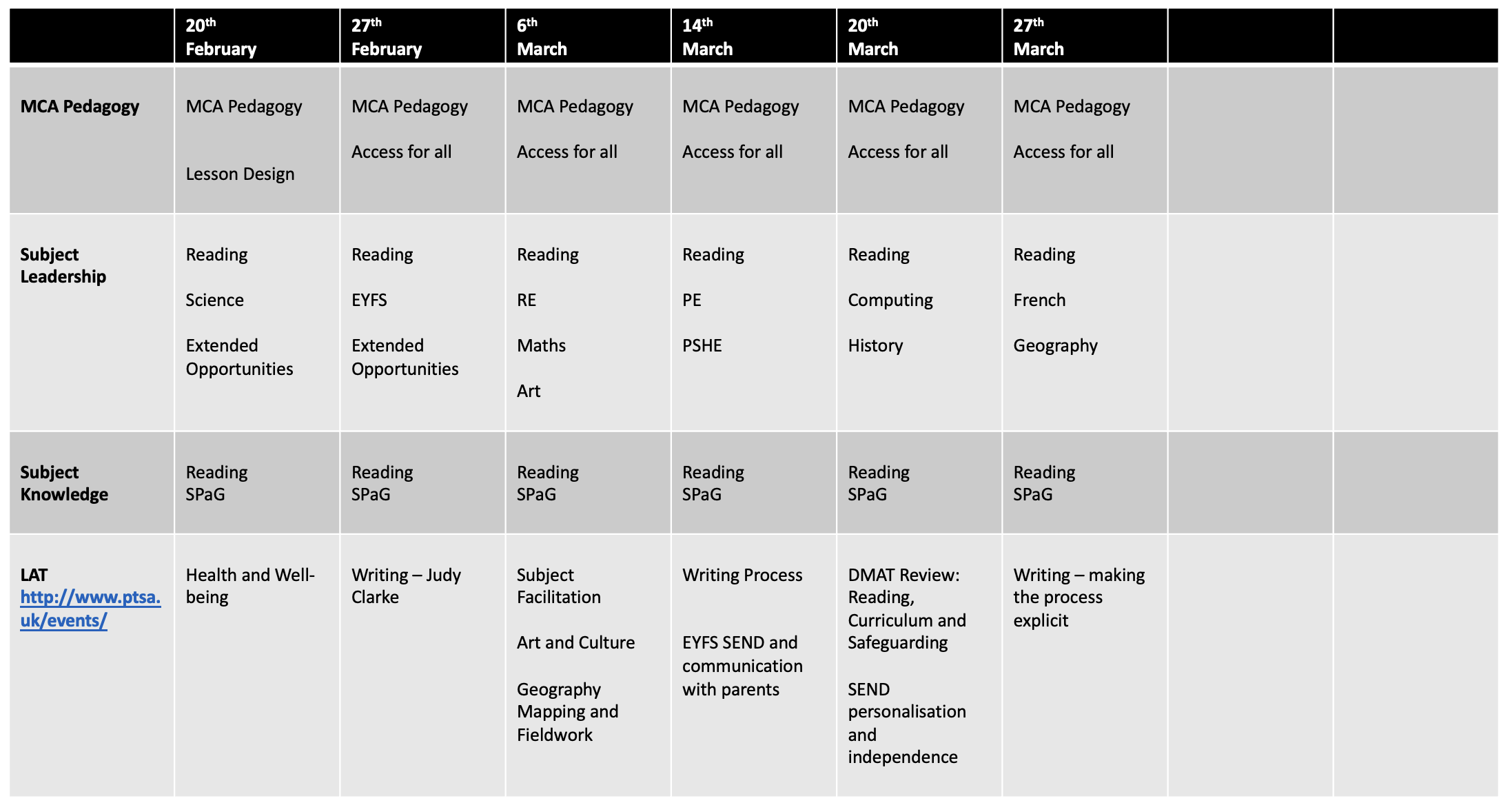
Calendar of study | Summer 5
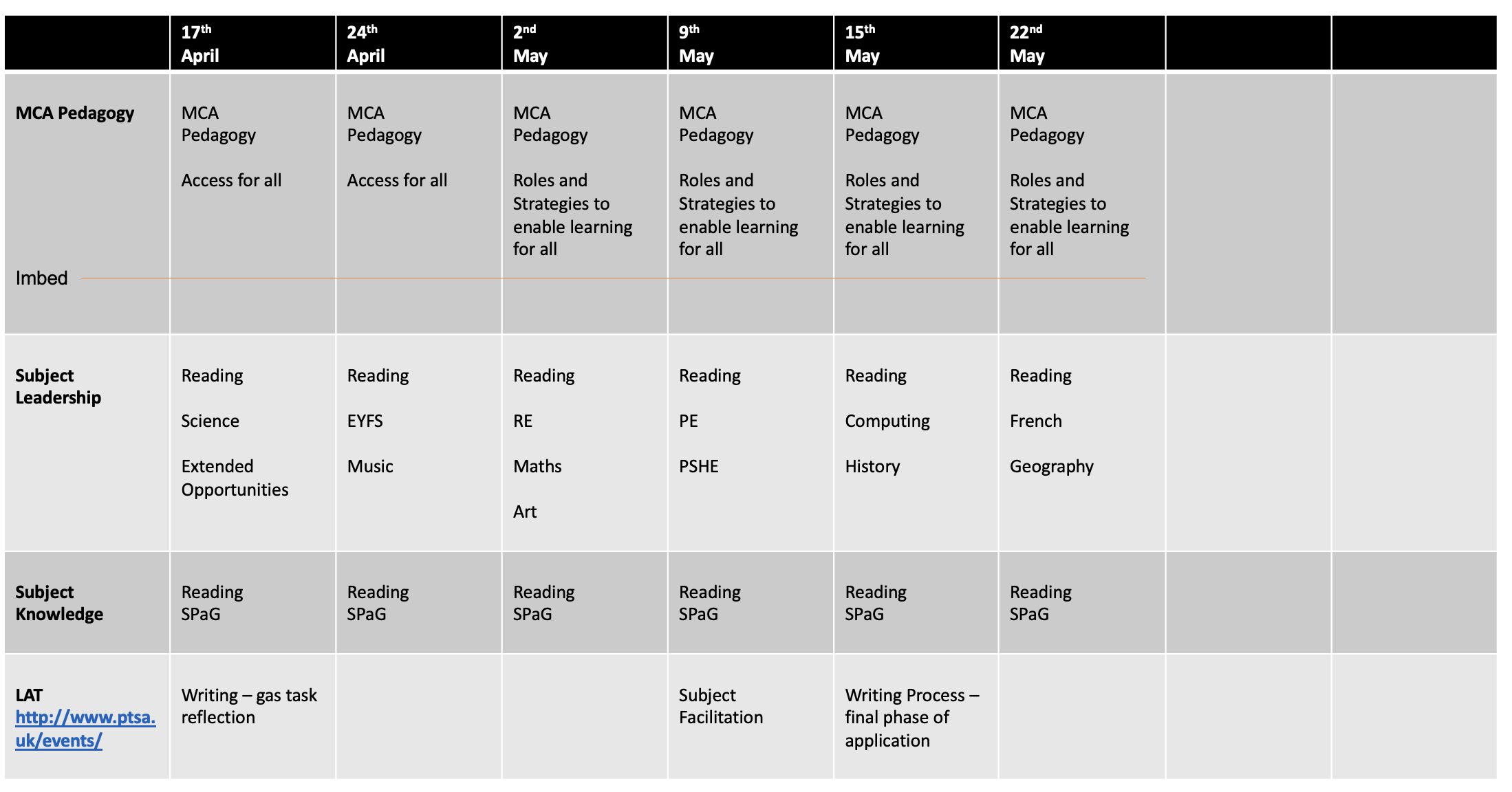
Calendar of study | Summer 6
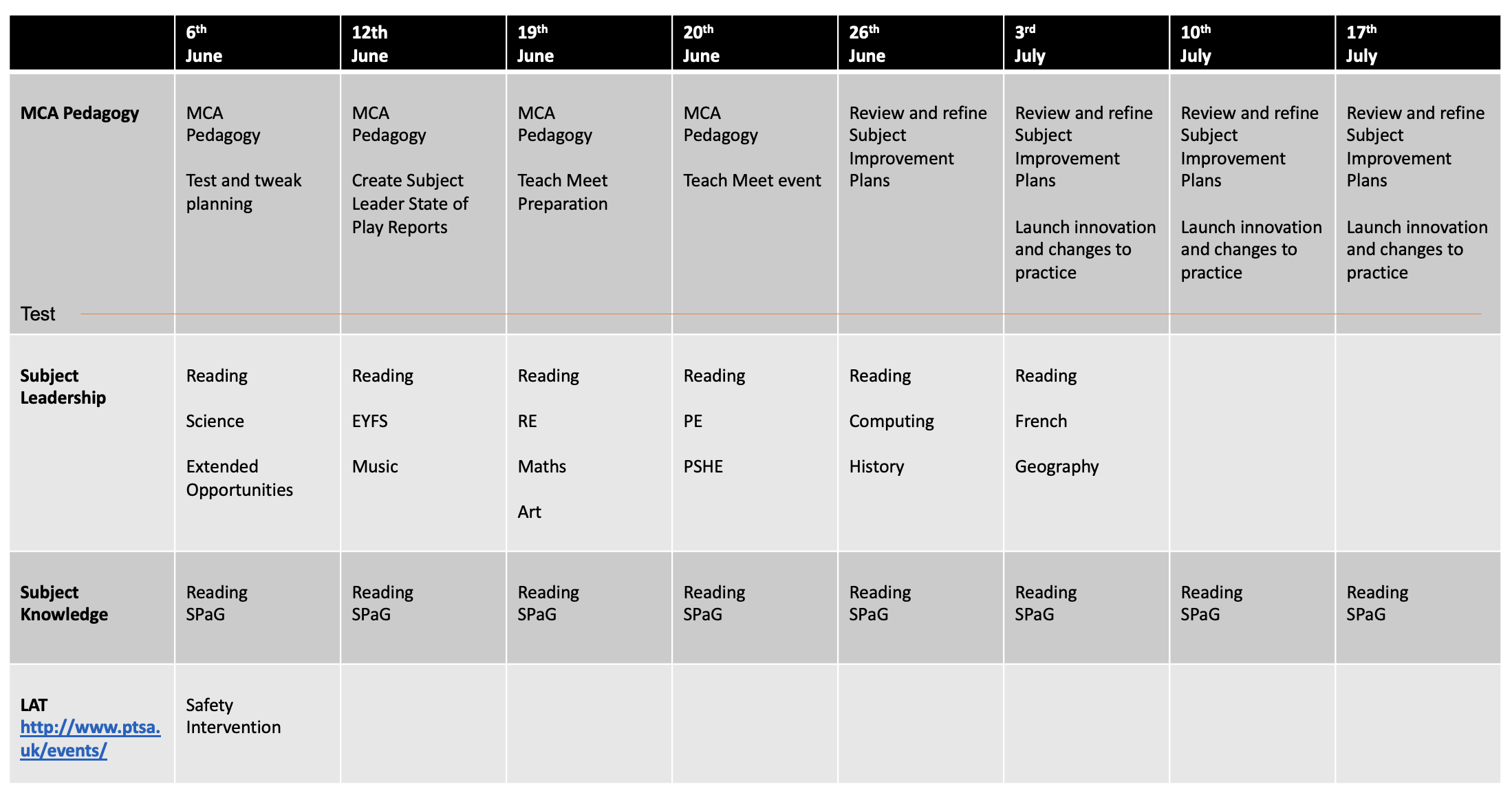
Reading for Professional Learning and Development
All staff have access to a wide range of reading material that will support them as they embark on their continuous professional development plans. As wide as offering a broad range of texts, staff are also signposted to specific articles, research papers, films and texts to support each stage of CPD study.
